As the first great Roman road, Via Appia is still regularly referred to in Italy as “Regina Viarum,” queen of roads. Although large sections are no longer visible, recognition from UNESCO has raised hopes of uncovering and preserving more sections of the 800km long road.
An increase in walkers, cyclists and tourists, keen to follow the route the Romans took, should also increase the number of visitors to the towns along the route. Many of them currently these locations offer property for sale at great prices.
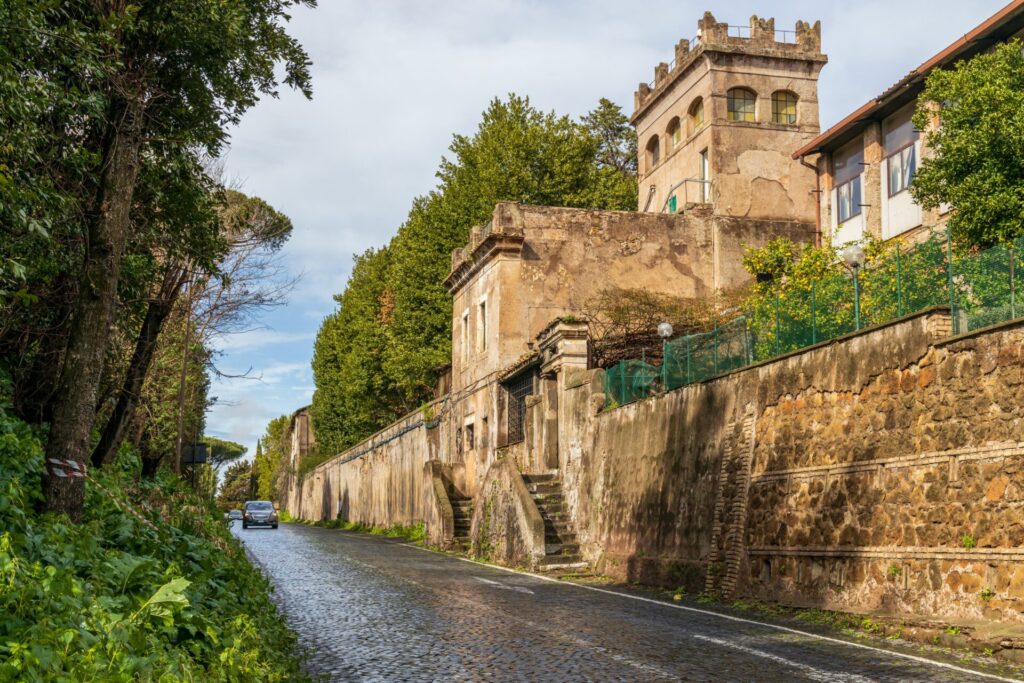
Via Appia antica (Appian way) in Rome, Italy
Find homes in Italy via our property portal.
UNESCO Status
Via Appia (Appian Way) was inscribed on the World Heritage List, on 31st July 2024. This makes it the 60th Italian site recognized by UNESCO. Other sites of the Roman period include the Archaeological Areas of Pompei, Herculaneum and Torre Annunziata. Plus, in Rome, there is the Colosseum, The Pantheon, the Roman Forum, and Castel Sant’Angelo.
The application for Via Appia to be awarded UNESCO status required a team effort from 12 provinces, 73 Municipalities and 14 Parks. As well as attracting more visitors, a site listed as World Heritage can gain international recognition and legal protection, there is also the possibility it could receive money from the World Heritage Fund, to facilitate its conservation.
Benefits of UNESCO status
Becoming a World Heritage Site will raise awareness of the Via Appia, and inspire tourists to walk where the Romans trod. Thus, the increase in visitor numbers to the territories it passes through will bring economic benefits to nearby communities.
As well as attracting more funds to uncover further stretches of the road, an increase in tourists could benefit local accommodation providers and nearby towns. In areas of interest to cyclists, walkers, and horse riders, related businesses could pop up. Such as cycle hire and stables.
Where is the Via Appia?
Starting in Rome, the Via Appia passes through the Italian regions of modern-day Lazio, Campania, and Basilicata, before reaching Brindisi in the southern region of Puglia. Today the SS7 road roughly follows it’s route from Rome to Brindisi, passing incredible scenery, towns and villages.
The SS7 takes travellers from Rome on a journey through Velletri, Terracina, Capua, Napoli, Marigliano, Avellino, Atripaldi, St. Angelo dei Lombardi, Lioni, Ruoti, Potenza, Laterza, Castellaneta, Taranto. Francavilla Fontana, and Brindisi.
Mapping the original route
Riccardo Carnovalini and author Paolo Rumiz first walked the Via Appia in 2015, trying to find the original route. However, the historic Via Appia road is no longer visible along much of the way. This is largely because road surfaces have been improved over the centuries and they have become faster roads. In other sections, the stones have been either removed or buried under agricultural land or ugly industrial zones, such as the steelworks as you approach Taranto.
Government funding
The Ministry of Cultural Heritage has earmarked 20 million euros to uncover more of the road and to map a walkable route. This may involve a few detours to avoid busy roads and to take in interesting sights, refreshments and accommodation facilities. While individual municipalities are keen to see work progress in their areas, more funds are needed for the archaeological work and upkeep.
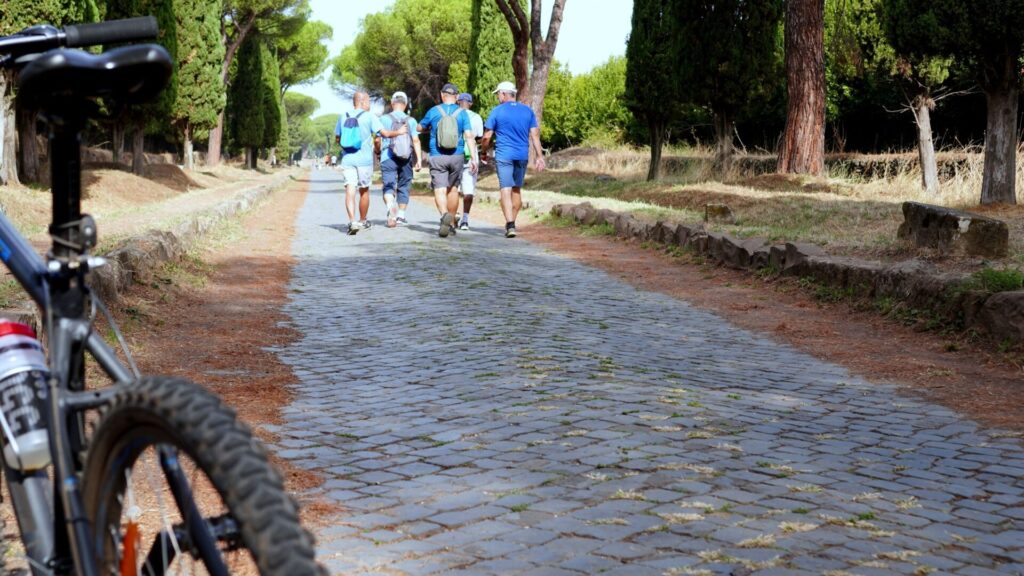
Tourists on the Via Appia Image: Canary4Stock I Shutterstock.com
History of the Via Appia
The Appian Way is a monument of Roman engineering, with work on the road beginning in 312 BC. On the instruction of Appius Claudius Caecus, the aim was to build a road to connect Rome to Capua (which is now on the outskirts of Caserta.)
It was then extended to Benevento, Venosa, Taranto and Brindisi. It was Caecus who also ordered the building of the first aqueduct in Rome, which still supplies its fountains today. The citizens of Ancient Rome then named all the roads you could use a cart on “Via”.
The Via Appia was extended to Benevento, Campania in 268 BC, and Venosa in Basilicata in 190 BC. After the defeat and retreat of Hannibal, they were able to continue the road through Basilicata and down to Taranto, Puglia. Finally, in the 2nd century BC, it reached Brindisi, where tall columns were built to mark its end.
Uses of the road
Stretching 360 miles from Rome to Brindisi, the 2,300-year-old Via Appia was originally designed to quickly move Roman Legions and supplies south. Ultimately reaching Brindisi where they could sail towards the East and Asia Minor.
The road enabled the growth of several cities along its route, and new settlements emerged. Over the centuries, this extraordinary piece of Roman engineering was used by merchants, and pilgrims to connect with the Mediterranean and the East. Eventually, after the Roman Empire began to collapse in A.D. 395, the Via Appia did begin to fall into disuse.
Structures along Via Appia
There are some interesting monumental buildings along the Via Appia including, triumphal arches, baths, amphitheatres and basilicas. There are also, canals, aqueducts, and bridges.
The Via Appia Antica section, from Rome up to the town of Frattocchie, has many monuments on the side of the road. For example, The mausoleum of Cecilia Metella (the wife of one of Julius Caesar’s generals) which looks like a circular castle tower. Other historic sites include Castrum Caetani, Capo di Bove, Villa dei Quintili and Santa Maria Nova. There are also Tombs, villas and an archaeological museum.
Building a Roman road
When building a driveway or terrace at your home in Italy, there is a lot we can learn from the way the Romans constructed roads. Two parallel grooves marked the position of the road, and the area between was dug out. Then, they built up layers of stone and clay (statumen), and stone and broken bricks (rudis) mixed with lime. The third layer was stone gravel (nucleus). Finally, it was covered in smooth stone slabs, fitted very snuggly together (pavimentum). The road was also slightly crowned in the middle for water run-off.
8 Cities along Via Appia
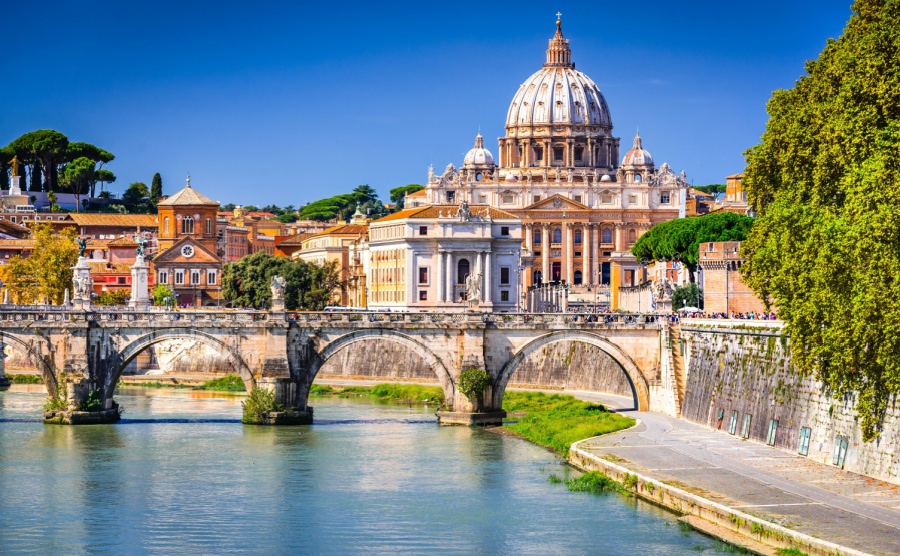
Vatican dome of Saint Peter Basilica (Italian: San Pietro) and Sant’Angelo Bridge, over Tiber river. I Image: ecstk22 via Shutterstock
1. Via Appia Antica, Roma (Rome)
The Via Appia began at Circus Maximus, passing by the Baths of Caracalla and the Aurelian wall. Since it was forbidden to bury the dead in the city, many were buried along the roads leading out of Rome. Family tombs were sometimes as large as a house.
Today the first two miles aren’t visible, but if you go to the Baths of Caracalla in a street named Via di Porta Sebastiano, the road passes under the Porta San Sebastiano gate in the Aurelian Wall and the Arch of Drusus. It is here that the road changes officially to Via Appia Antica. The Appia Antica Archaeological Park is the best preserved and most walkable section of the road.
Property near Via Appia Antica
A 500-metre square villa with large grounds, in the Via Appia Antica area of Rome, currently costs around 3 million euros (2024). However, in the Lazio region as a whole, you will find some lovely stone farmhouses, to suit every budget.
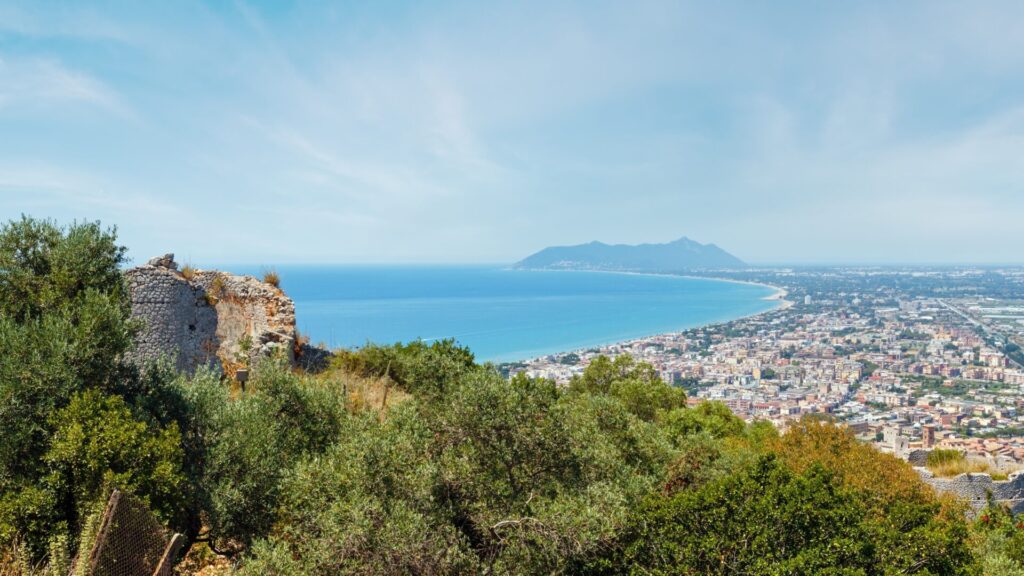
2. Terracina (Anxur)
Previously named Anxur, the coastal town of Terracina lies between Rome and Naples. When the road left the city of Rome, it travelled through wealthy suburbs on its way to the Appian Mountains and over the former Pontine Marshes to the coastal town of Terracina.
Evidence of Terracina’s Roman history is still visible with the remains of a forum, temple, theatre, baths, and villas once owned by emperors.
Of particular note are the ruins of the temple of Jupiter Anxur and the ancient Anxur wall, which have spectacular views of the modern town and sea.
Property near Terracina
A two-bedroom apartment near the Via Appia sells for around €140,000 to €240,000. Houses are priced from €225,000.
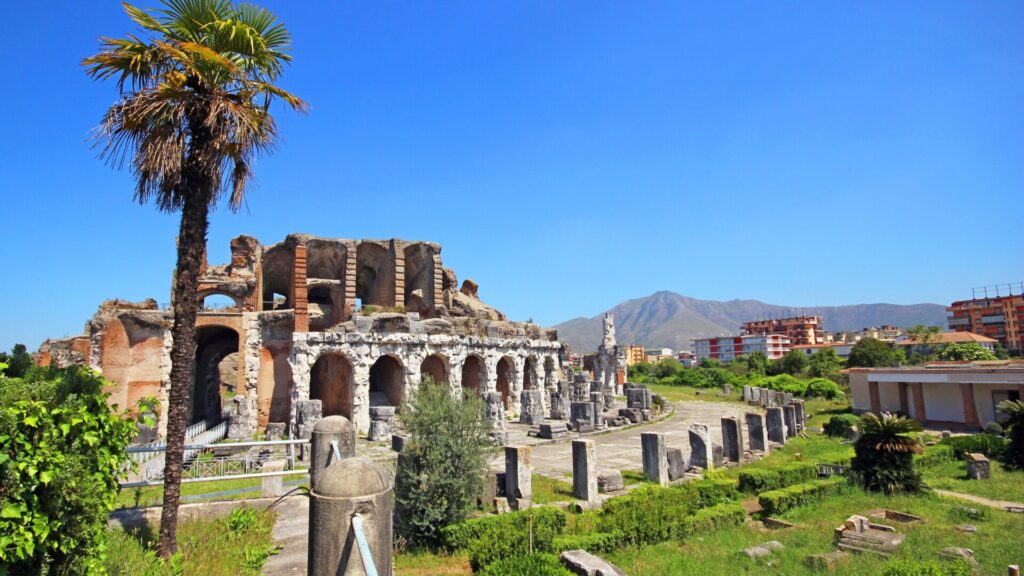
Roman amphitheatre in Capua, Italy
Image: Zbigniew Guzowski I Shutterstock.com
3. Capua
From Terracina, the Appian Way followed the western coast, to Capua, making the original road about 210 km long. Capua is located in the Campania region, 25km (16 miles) south of Naples.
Around the 2nd century BC, the city of Capua reached such political and economic importance, that it had the same number of inhabitants as Rome. Today the population is less than 19,000, while nearby Caserta has 72,000.
Close to Via Appia is an Amphitheatre built between the 1st and 2nd centuries AD. It is the second largest in Italy after the Colosseum. Next to this, is the Museum of the Gladiators and a Gladiator School. It was in this area that the well-known revolt of Spartacus broke out in 73 BC, threatening the city of Rome.
Property in Capua
Property prices in Capua are much cheaper than in Rome, as low as €40,000 for an apartment and €190,000 for a house.
4. Venusia (Venosa)
Venosa is situated on the lower slopes of Mount Vulcano, north of Potenza in the Basilicata region. Today there are around 12,000 inhabitants.
However. When Venosa was taken by the Romans in 291 BC, 20,000 Romans were sent there to populate the area and form a municipium. You can still see the ruins of the Roman Amphitheatre and the Roman baths.
From its position on the Via Appia, Venosa became an important Roman garrison town. Stones from the nearby Roman amphitheatre are believed to have been built into the walls of the abbey church of Santa Trinità in around 1059.
Property in Venosa
In Venosa a small flat in the historic centre can cost from €69,000, and a house can cost as little as €140,000.
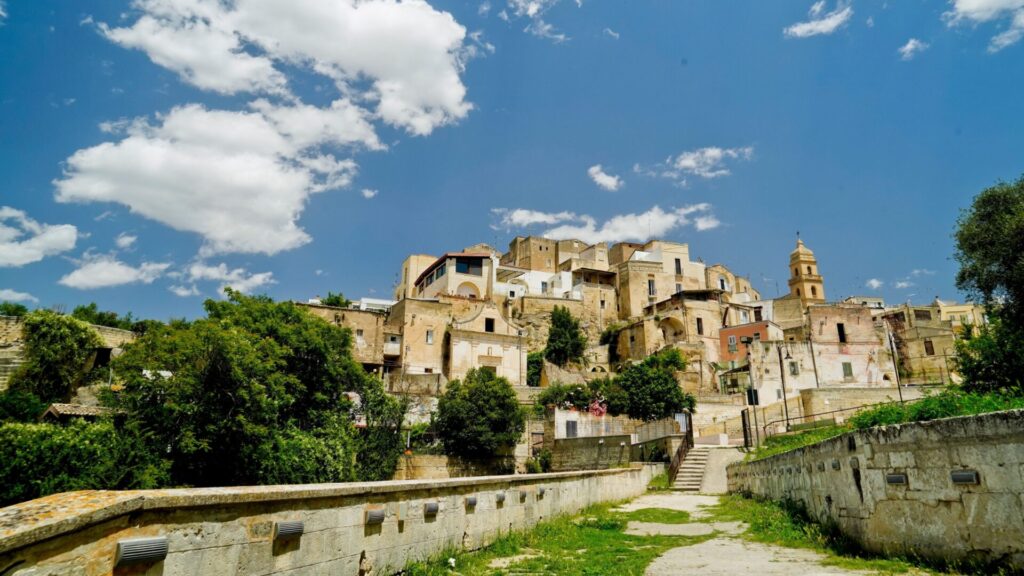
The historic centre of Gravina di Puglia Image: Studioangifoto I Shutterstock.com
5. Gravina di Puglia
Just twenty miles (32km) from Venosa, The Via Appia, passed through Gravina, before heading across stunning Puglian countryside, on its way to the coastal town of Taranto.
Gravina di Puglia is a small town located on the edge of a ravine above a river. The tall bridge across the ravine will be recognisable to anyone who watched the 2021 James Bond film, No Time to Die.
Property in Gravina di Puglia
Properties currently for sale ( August 2024) range from a house in the historic centre needing renovation asking €70,000 to a 500m2 luxury palazzo priced at €2,850,000. The types of property for sale vary greatly, as do the conditions and pricing.
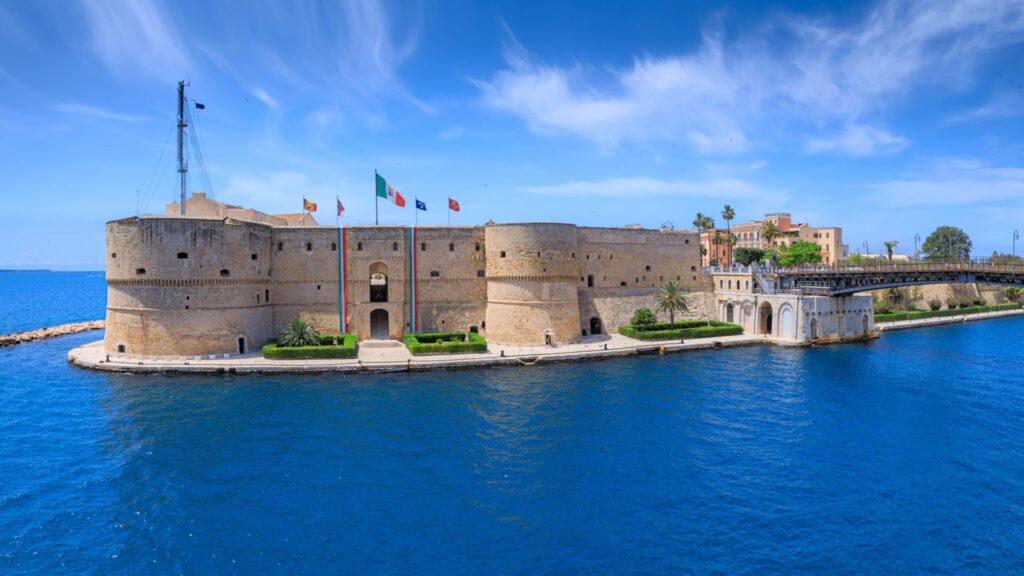
Taranto cityscpae and Swing Bridge in the distance_Image: vololibero I shutterstock.com
6. Taranto
Taranto was founded in 706 BC by Greek immigrants from Sparta. Despite the Romans trying to expand their empire south, Taranto kept holding them back, preventing Rome from controlling Southern Italy.
Taranto was assisted in battle by Pyrrhus, the king of Epirus, who surprised Rome by bringing elephants to the battle. However, in 272 BC Rome eventually did succeed and subsequently extended the Via Appia to the port of Brundisium (Brindisi).
Property in Taranto
An apartment in Taranto’s historic centre can cost from €89,000. Even less if you are willing to take on some serious renovation. A big house needing renovation can cost €145,000. Some have also previously been included in the “Homes at 1 euro project”.
7. Mesagne
On leaving Taranto, the Via Appia headed towards a rest stop near Grottaglie, known as Mesochorum. Today, this town is famous for its numerous potters. The road then passed by the hilltop town of Oria and continued towards Brundisium (Brindisi).
However, before reaching the port it passed another check-point called Scamnum, located in the area near Muro Tenente, not far from Mesagne.
Just outside the town of Mesagne, archaeologists have unearthed the last visible stretch of the Appia’s original stones. Mesagne is a town with a charming historic centre and castle. In recent years it has invested in its heritage and got as far as finalist for Italy’s 2024 Capital of Culture.
Property in Mesagne
Small apartments in the historic centre are currently priced from €89,000. A house needing renovation costs about the same, before renovation costs are added.
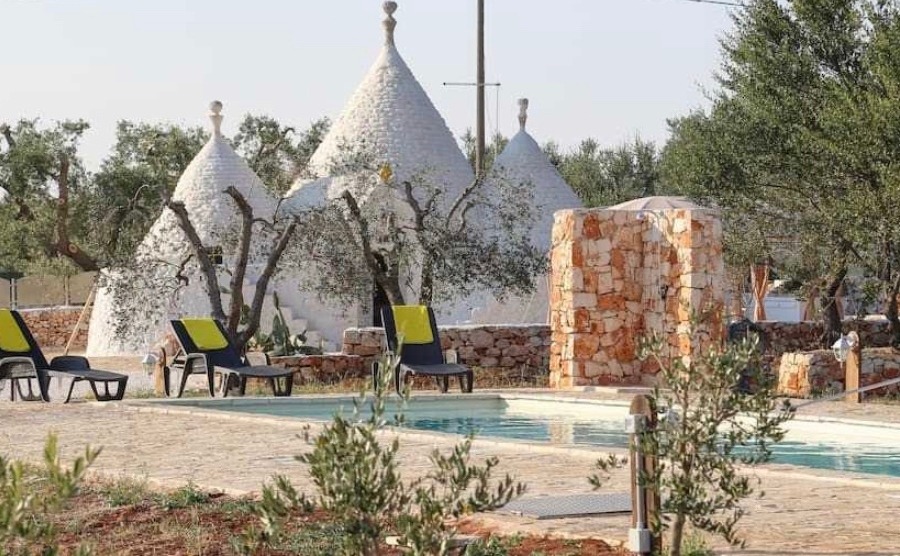
Restored trulli in Ostuni, Brindisi
8. Brindisi
Near the port of Brindisi, are a set of monumental steps that climb from the waterfront to a small square with a column and the remains of another. Historically, it’s believed the columns marked the end of the Via Appia.
In the centre of the city, under the G. Verdi Theatre are also the remains of a street, paving, mosaic, and thermal baths from the end of the 1st century BC.
Today, Brindisi is a popular place to live and holiday, due to its sea, road and air connections. There are beaches nearby and an International school for children.
Property in Brindisi
Within the province of Brindisi, you will find rural villas suitable for use as holiday homes. Plus, village houses and apartments. In the countryside, there are Masserie, which are fortified farmhouses, that have the feel of a Roman villa, due to their layout around a courtyard.
Flats in the city of Brindisi, with a sea view start at €200,000. There are trulli and villas for sale in the countryside for less than €100,000, but they will need some renovation or modernising. Rural properties with pools start at €150,000 and nearer to €300,000 for one in good condition. Large Masserie needing renovation starts at around €450,000.
You might also like:












